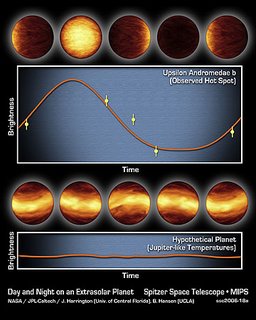Tuesday, October 17, 2006
Night and Day on an Exoplanet
 Image Credit Credit: NASA/JPL-Caltech/R. Hurt
Image Credit Credit: NASA/JPL-Caltech/R. Hurt Of the 210 exoplanets discovered so far, around 10% of them scream around their Suns in tight orbits, much closer than Mercury is to our Sun. This has earned them the nickname "hot Jupiters" (as they are almost all Jupiter sized or above)*.
Upsilon Andromedae b , is such a world. At 69% the mass of Jupiter, it s year is just under five days long. Although this world must be tidally locked to its Sun (hence always having the same side face the Sun), massive jet streams in its super-heated atmosphere would redistribute the heat, making the planet an even temperature.
However, the latest data from the Spitzer Infra-Red telescope suggest that this is not the case.
 Image Credit NASA/JPL-Caltech/J. Harrington (Univ. of Central Florida), B. Hansen (UCLA)
Image Credit NASA/JPL-Caltech/J. Harrington (Univ. of Central Florida), B. Hansen (UCLA)Spitzer looked for fluctuations in the infrared intensity of Upsilon Andromedae and found that it fluctuated with the orbital period of Upsilon Andromedae. If the night and day side of this planet were similar, then they would have seen no fluctuations, but as they did, this suggests that the night and day sides of the planet are very different temperatures (See this page for cool videos of the orbit). The day and night sides of the planet differ by about 1,400 degrees Celsius. This means that the hot atmosphere from the bright side must dramatically cool as it circulates. Quite how this happens is not clear.
Back in the 90's the idea that we could every detect planets around other world seemed incredible. Now we can measure the contents of their atmospheres and watch their night and day progress. That's amazing.
* Planets around the Size of Neptune and Smaller have been found, but they are not quite so close in)



 Click to read about or order
Click to read about or order Click to read about or order
Click to read about or order Click to read about or order
Click to read about or order Click to read about or order
Click to read about or order




